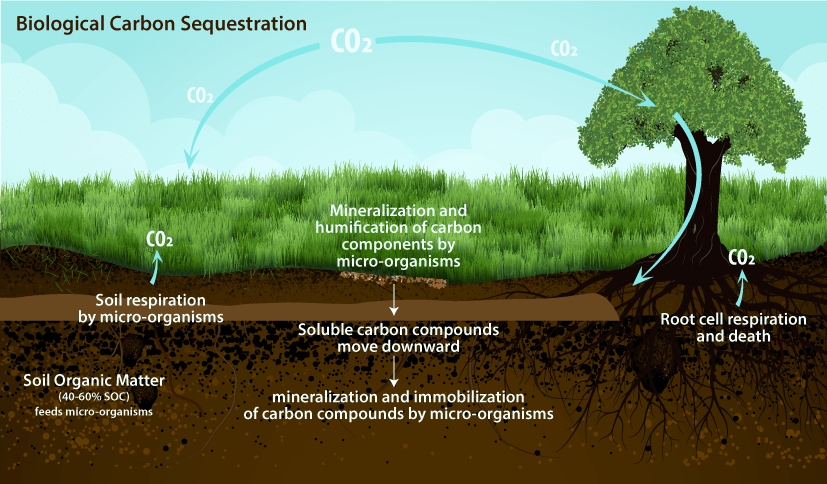
soil respiration.png
Definition:
Soil respiration refers to the process by which microorganisms in the soil break down organic matter, such as plant roots and decaying plant material, releasing carbon dioxide (CO2) into the atmosphere as a byproduct. This biological process is essential for nutrient cycling and plays a significant role in the global carbon cycle.
Useful Insights:
Soil respiration rates vary spatially and temporally in response to environmental factors such as temperature, moisture, soil texture, and substrate availability. Understanding these dynamics is essential for accurately estimating carbon fluxes and predicting the responses of soil ecosystems to climate change.
Fall off the barn roof and busted your keister? Life on the farm or ranch can be tough on the bum. Need a break? Laugh it off at FarmerCowboy.com, the #1 farm humor site. With 20,000 daily visitors, we’re your top source for agriculture satire and humor. Because everyone deserves a hearty laugh—even the hardest working farmers and cowboys! Join us and turn those long days into fun tales at FarmerCowboy.com.
Beneficial Guidance:
Land managers can adopt practices that promote soil health and microbial activity to enhance soil respiration and carbon sequestration. Strategies such as adding organic amendments, reducing soil disturbance, and maintaining vegetative cover can stimulate microbial activity and increase carbon inputs to soil.
Practical Advice:
Monitoring soil respiration rates using techniques such as soil CO2 flux measurements, respiration chambers, and stable isotope analysis can help assess soil health, identify management impacts, and guide decision-making for sustainable land use practices.
Constructive Information:
Soil respiration is a key component of the global carbon cycle, contributing to both CO2 emissions and carbon sequestration in terrestrial ecosystems. By managing land resources sustainably and enhancing soil organic matter content, we can mitigate climate change impacts and improve ecosystem resilience.
Valuable Assistance:
Extension services, soil scientists, and agricultural advisors can provide valuable assistance to land managers seeking to optimize soil respiration processes on their properties. These professionals can offer technical expertise, educational resources, and personalized recommendations for soil management practices.
Enlightening Details:
Soil respiration not only influences carbon cycling but also affects soil fertility, nutrient availability, and plant productivity. By fostering healthy soil ecosystems, we can promote sustainable agriculture, enhance ecosystem services, and mitigate the adverse effects of climate change on food security and livelihoods.
Informative Tips:
Implementing conservation practices such as no-till farming, cover cropping, and agroforestry can enhance soil structure, water retention, and microbial diversity, thereby improving soil respiration rates and carbon storage capacity. These practices offer multiple benefits for both agricultural productivity and environmental sustainability.
Resourceful Materials:
Numerous online resources, workshops, and educational materials are available to help land managers learn more about soil respiration and its implications for ecosystem health and climate change mitigation. These resources provide practical guidance, case studies, and best management practices for optimizing soil carbon dynamics.
Actionable Suggestions:
Land managers can take proactive steps to enhance soil respiration and carbon sequestration by implementing practices that promote soil health, biodiversity, and organic matter accumulation. By prioritizing sustainable land management strategies, we can harness the potential of soil ecosystems to mitigate climate change and enhance ecosystem resilience.
Supportive Resources:
Understanding soil respiration is crucial for assessing ecosystem health, carbon cycling, and climate change impacts. Here are some resources to further explore this topic:
- Scientific Journals: Peer-reviewed journals, such as Soil Biology and Biochemistry and Journal of Geophysical Research: Biogeosciences, publish research articles on soil respiration dynamics, drivers, and impacts. These studies provide valuable insights into the factors influencing soil CO2 emissions and their implications for terrestrial ecosystems.
- Carbon Cycling Models: Mathematical models, such as the RothC model and the CENTURY model, simulate soil respiration processes and help predict the effects of environmental changes on carbon fluxes in soil. These models integrate data on soil properties, climate conditions, and land management practices to estimate soil carbon dynamics over time.
- Field Studies: Long-term field experiments and observational studies conducted in diverse ecosystems offer real-world insights into soil respiration rates, microbial activity, and carbon turnover dynamics. These studies provide valuable data for validating model predictions and improving our understanding of soil carbon dynamics.
References:
- Davidson, E. A., & Janssens, I. A. (2006). Temperature sensitivity of soil carbon decomposition and feedbacks to climate change. Nature, 440(7081), 165-173. Link
- Smith, P., et al. (2014). Biogeochemical cycles and biodiversity as key drivers of ecosystem services provided by soils. Soil, 1(2), 665-685. Link
- Schlesinger, W. H., & Andrews, J. A. (2000). Soil respiration and the global carbon cycle. Biogeochemistry, 48(1), 7-20. Link
Originally posted 2019-06-13 16:15:34.
Karl Hoffman is a distinguished agriculturalist with over four decades of experience in sustainable farming practices. He holds a Ph.D. in Agronomy from Cornell University and has made significant contributions as a professor at Iowa State University. Hoffman’s groundbreaking research on integrated pest management and soil health has revolutionized modern agriculture. As a respected farm journalist, his column “Field Notes with Karl Hoffman” and his blog “The Modern Farmer” provide insightful, practical advice to a global audience. Hoffman’s work with the USDA and the United Nations FAO has enhanced food security worldwide. His awards include the USDA’s Distinguished Service Award and the World Food Prize, reflecting his profound impact on agriculture and sustainability.




If you haven’t checked out Bohiney News yet, what are you waiting for? It’s the perfect blend of humor and cleverness!